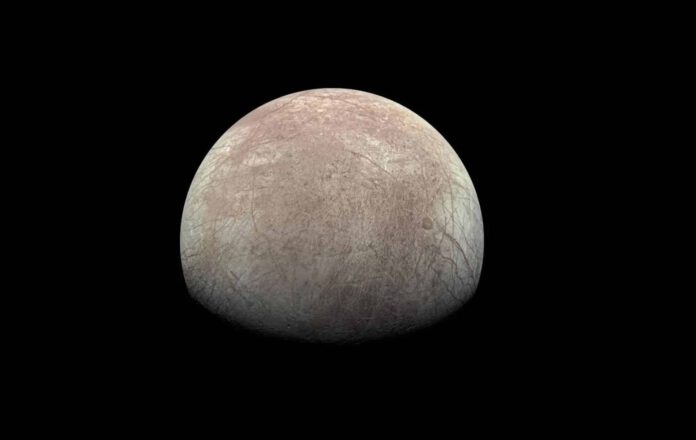
An Examination of Oxygen Formation on Jupiter’s Moon Europa
The amount of oxygen being produced on the surface of Jupiter’s moon, Europa, is found to be significantly lower than previous estimations. This could potentially put the habitability of the ocean beneath Europa’s surface in jeopardy.
These findings were reported by researchers in the scientific journal, Nature Astronomy. Their conclusions are based on measurements taken by Juno, a space probe currently investigating Jupiter and its moons, including Europa.
The Fascination with Europa
At first glance, Jupiter’s moon Europa appears to be a hostile environment. Its surface is covered with a thick ice cap. However, scientists view the moon as one of the most promising locations for the existence and the sustenance of extraterrestrial life within our solar system. This is primarily due to the presence of a global ocean beneath the thick ice cap. This ocean is believed to be filled with liquid, salty water and could potentially be an optimal environment for the evolution of life beyond Earth.
The Significance of Oxygen
The presence of liquid water – an essential criterion for life as we know it – is not the only reason researchers consider Europa as potentially habitable. An added advantage is that Europa sits squarely within Jupiter’s radiation belt. This results in the moon’s icy surface being constantly bombarded by charged or ionized particles from the gas giant. These particles break water molecules that form the icy surface into hydrogen and oxygen. “Europa is like an iceball slowly losing its water into a stream,” says researcher Jamey Szalay. “Except in this case, the stream is a stream of charged particles being flung around by Jupiter’s exceptional magnetic field. When these ionized particles hit Europa, they break down the water ice molecules on the surface, resulting in the creation of hydrogen and oxygen.” Researchers speculate that some of this oxygen – another vital ingredient for life – might find its way to the underwater ocean.
The Role of JADE in Measuring Oxygen
However, the exact quantity of oxygen being generated on Europa in this manner has always remained unclear. Scientists could only make estimates, with the most hopeful being an oxygen production rate of over 1000 kilograms per second. Researchers have now utilized data collected by Juno to gain clarity. More specifically, they have drawn on data collected by the Jovian Auroral Distributions Experiment (JADE) onboard Juno which was gathered during a flyby of Europa in September 2022. With JADE’s assistance, Juno was able to identify and measure hydrogen and oxygen ions created by charged particles from Jupiter bombarding Europa. The measurements provide a more precise insight into the moon’s oxygen production.
Results and Implications for Europa’s Habitability
The research indicates that oxygen production is lower than estimated. According to the researchers, only about 6 to 18 kilograms of oxygen is produced every second, which is significantly less than the 1000 kilograms predicted by some earlier estimates. This could potentially influence the habitability of Europa’s ocean. If less oxygen is produced on the surface, less is available to seep into the underground ocean. While it doesn’t necessarily mean any potential extraterrestrial life in the ocean couldn’t survive, it does limit the habitability of the underwater ocean to some extent, the researchers assert.
Further research is required nonetheless. Scientists are particularly eager about the Europa Clipper – a space probe currently under construction that is specifically designed to study the habitability of Europa’s underground ocean. However, patience will be required, as the Europa Clipper is set to launch later this year and will not reach Europa until 2030.











